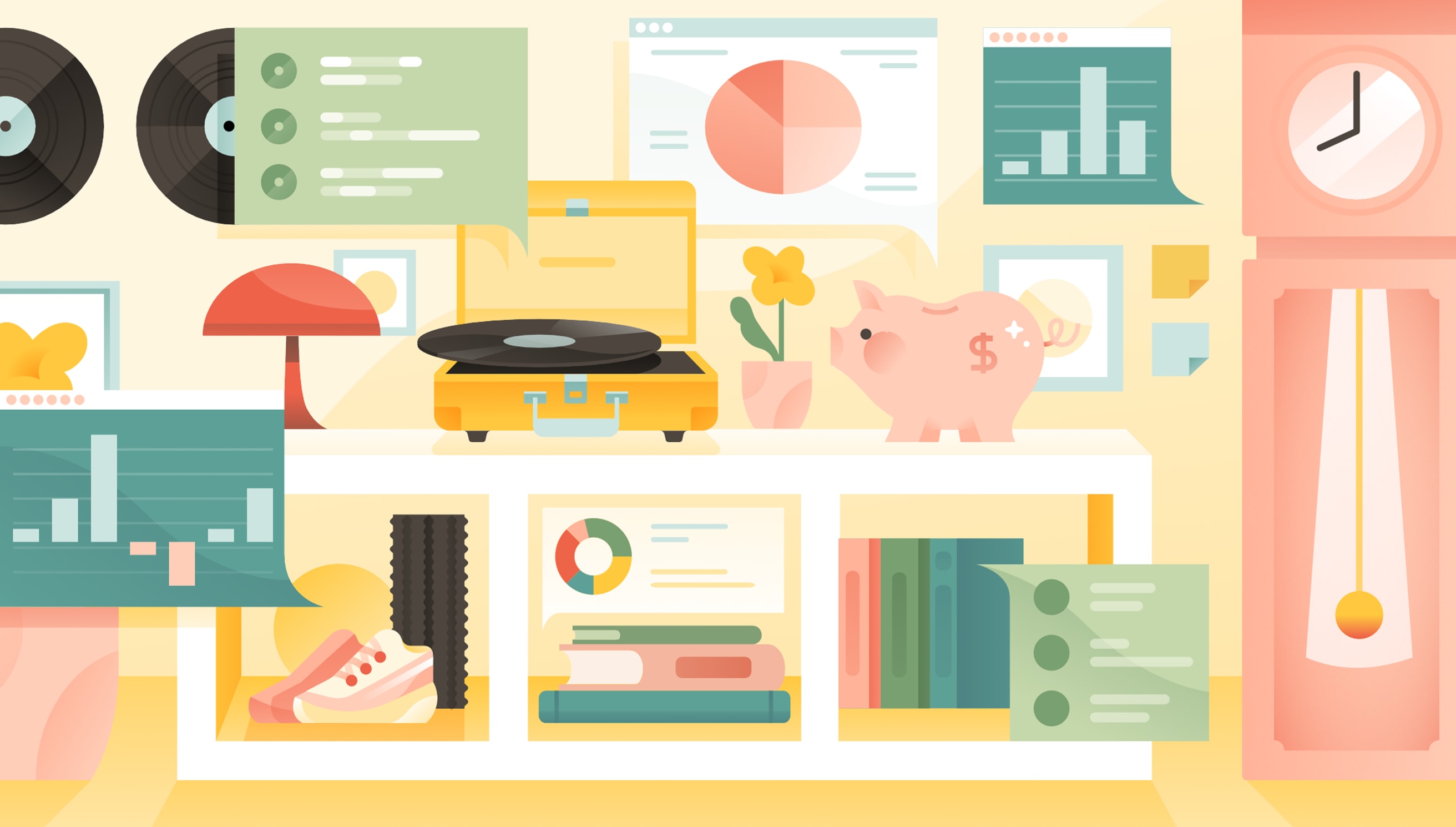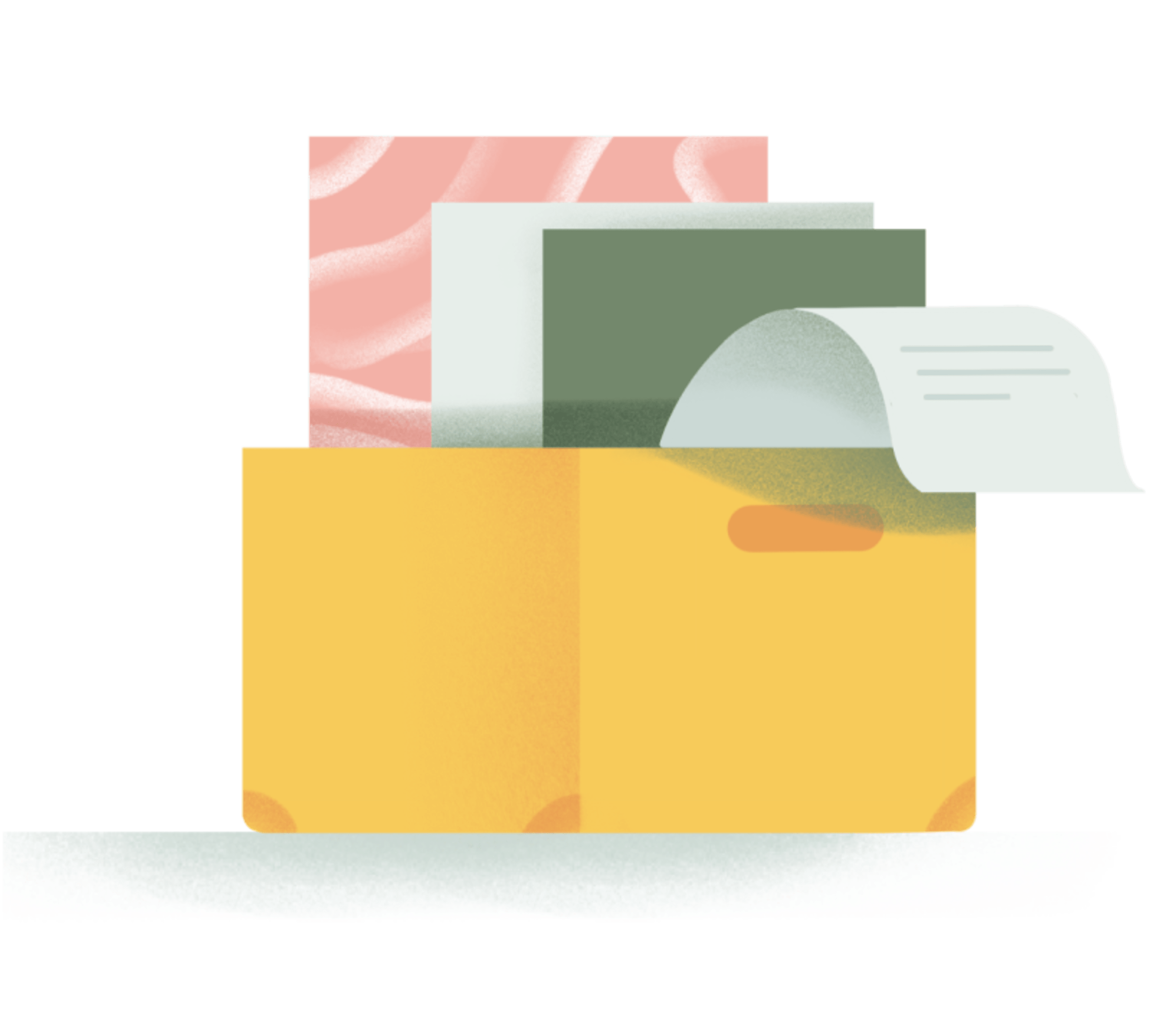9,437 steps today, 12 tasks completed, and 7 hours and 13 minutes of rest last night.
Here's the thing about measuring bits of your life: It's surprisingly addictive. After all, who doesn't want to know if they're getting better sleep after cutting out coffee? Or if they're as productive as they think on Mondays?
Welcome to the world of quantified self — where people track various aspects of their lives to gain insights and improve. But here's where things get messy. Thousands of apps and digital trackers promise to track everything from meditation to how much water you drink in a day.
And when it comes to choosing one of those apps?
Deep breaths. 😤😮💨
But trust us: It doesn't have to be this complicated.
In this guide, we'll explore 14 apps that can help you quantify yourself. We'll show you how to create a dead-simple tracking system using Todoist as your hub and just one or two companion apps. Because let's face it — you probably have better things to do than spend half your day logging data about the other half.
What is quantified self?
The quantified self is a movement in which you track aspects of your daily life, from exercise intensity to sleep patterns. It helps you understand your habits, behaviors, and patterns through data. By measuring these daily patterns, you turn hunches into clear insights you can use to improve yourself.
The term "quantified self" was coined in 2007 by two Wired magazine editors, Kevin Kelly and Gary Wolf. They noticed people using digital tools, phones, and wearable devices to track personal data.
So, they organized the first Quantified Self meetup in the Bay Area. The meetups became a show-and-tell in which participants would share quantification methods and answer questions like:
What did they do?
How did they do it?
What did they learn?
The success of this first meetup sparked a global movement. Wolf and Kelly created quantifiedself.com. And its slogan, "self-knowledge through numbers," became the movement's guiding principle.
If you've ever checked your step count? Tracked your expenses? Or the tasks you do in a day? That's quantified self in action.
Time tracking and productivity measurement apps
Do you know the difference between being busy versus productive? If you often reach the end of the day, thinking “Where did all my time go?” or “I think I waste too much time in meetings,” tracking your time and productivity can help you transform these vague feelings into quantifiable action plans.
How you spend your time can reveal:
Your intentions (what you plan to do)
Your actions (what you actually do)
Your effectiveness (how well you do it)
These apps help you track and understand these patterns — so you can make intentional changes that ripple through every aspect of your life.
1. Todoist
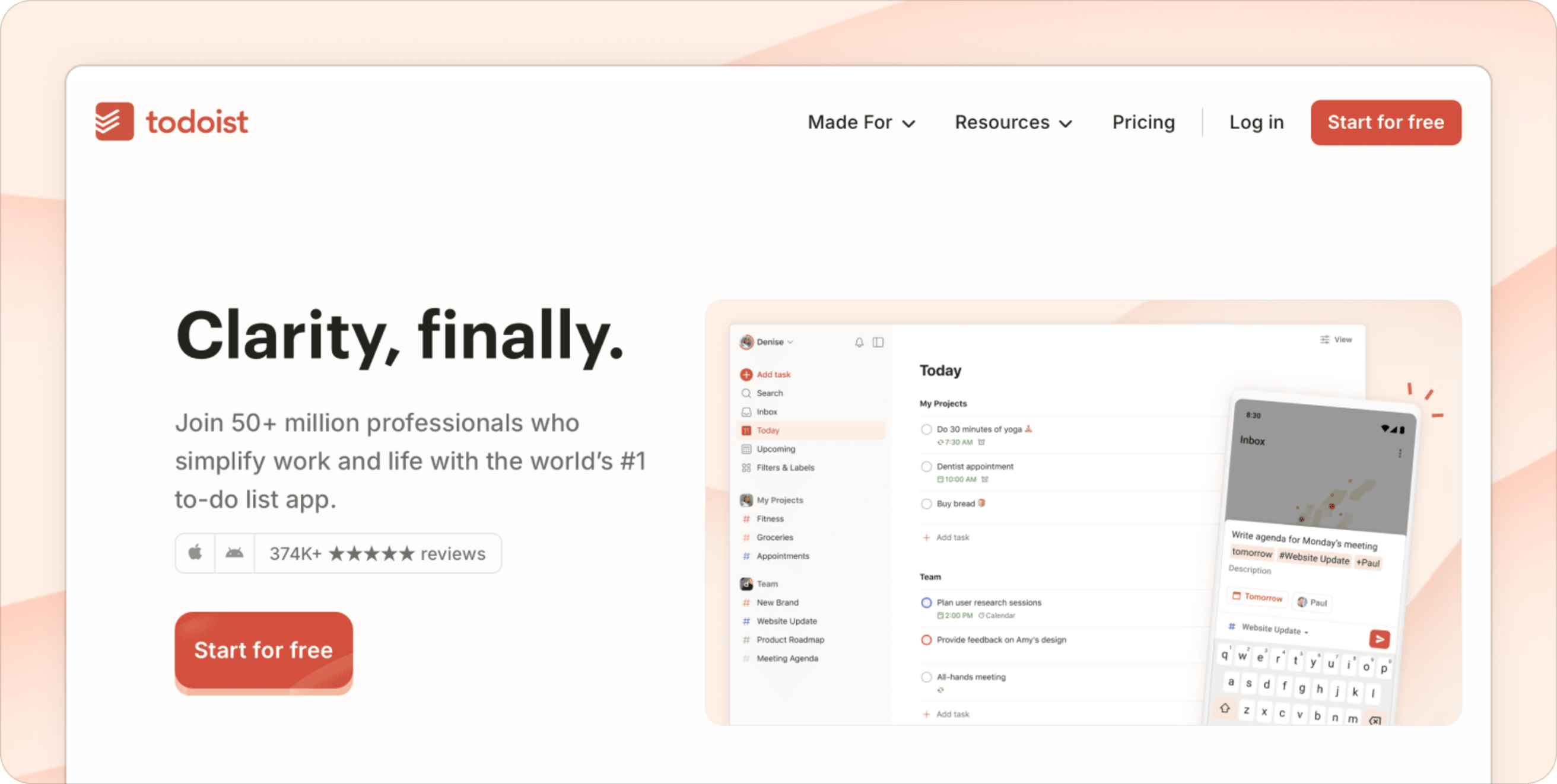
Todoist is a task manager app that helps you organize your work and life. It’s all your projects and deadlines in one place.
Todoist was designed to be as simple or as powerful as you need it to be. You can create custom sections for different areas of your life — including work assignments, project planning, personal tasks, or household responsibilities.
Just set priority levels for urgent tasks and view your schedule by day, week, or month. Also, you can attach files, and leave emoji reactions or comments, making it a great tool for collaboration.
What’s cool about it:
Your tasks and calendar finally play nice together with the calendar sync
Type "tomorrow at 3 pm" and Todoist’s natural language input handles the scheduling
Organize tasks into clean, logical spaces for work and life with projects and sections
Drag-and-drop tasks in a visual Kanban layout in the board view
Create powerful views like "all priority tasks due this week" with custom filters
Share projects and assign tasks to team members with collaboration tools
Best for: Anyone who wants to build a reliable system for tracking everything they need to do. Todoist is especially powerful for professionals juggling day-to-day deliverables, quarterly plans, and strategic goals.
Price tag:
Free: Enough features to get started and fall in love
Pro: $4/month (billed annually) with more projects and calendar view
Business: $6/month per user (billed annually) for team collaboration
2. RescueTime
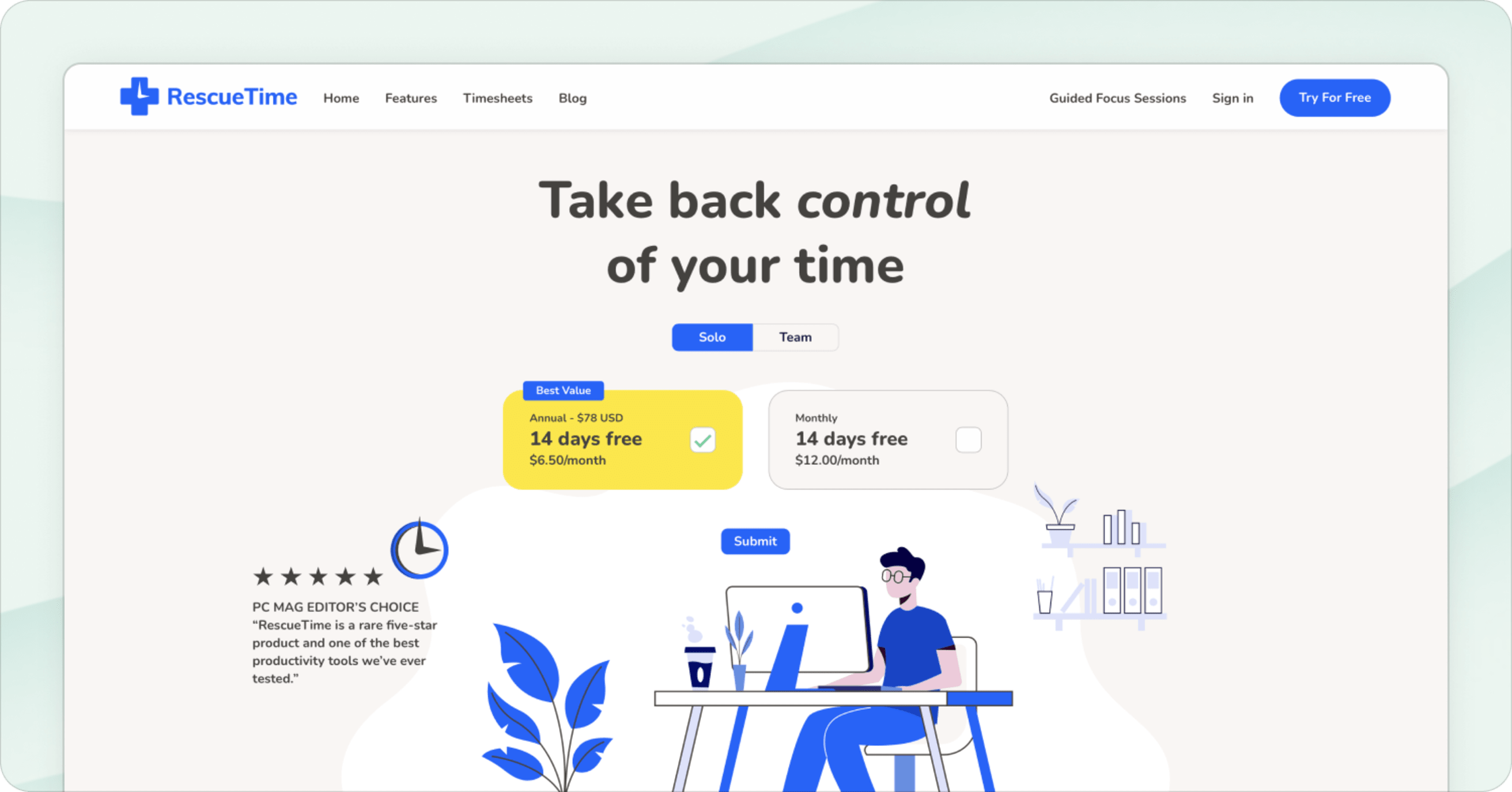
RescueTime is a quantified time tracking tool that helps you understand exactly where all your time is going and build better habits. You can leave it to run in the background while you work. Once you're finished, you can check your usage trends.
But RescueTime isn't only a tracking tool. It also allows you to set goals on how you'd like to spend your time and alerts you when you stray from them.
What's cool about it:
Categorize and label activities (productive or distracting)
Block distracting websites with focus sessions
Set daily goals (for productivity and projects)
Analyse reports by day, month, and year
Get notifications for when you're getting distracted or reaching goals
Best for: Someone who wants to understand their digital habits and improve focus. RescueTime is perfect for workers, freelancers, or anyone who wants to optimize their screen time.
Price tag:
Free: Basic time tracking and weekly reports
Premium: $12/month with advanced features and blocking tools
Teams: $9/month per team member
3. Toggl
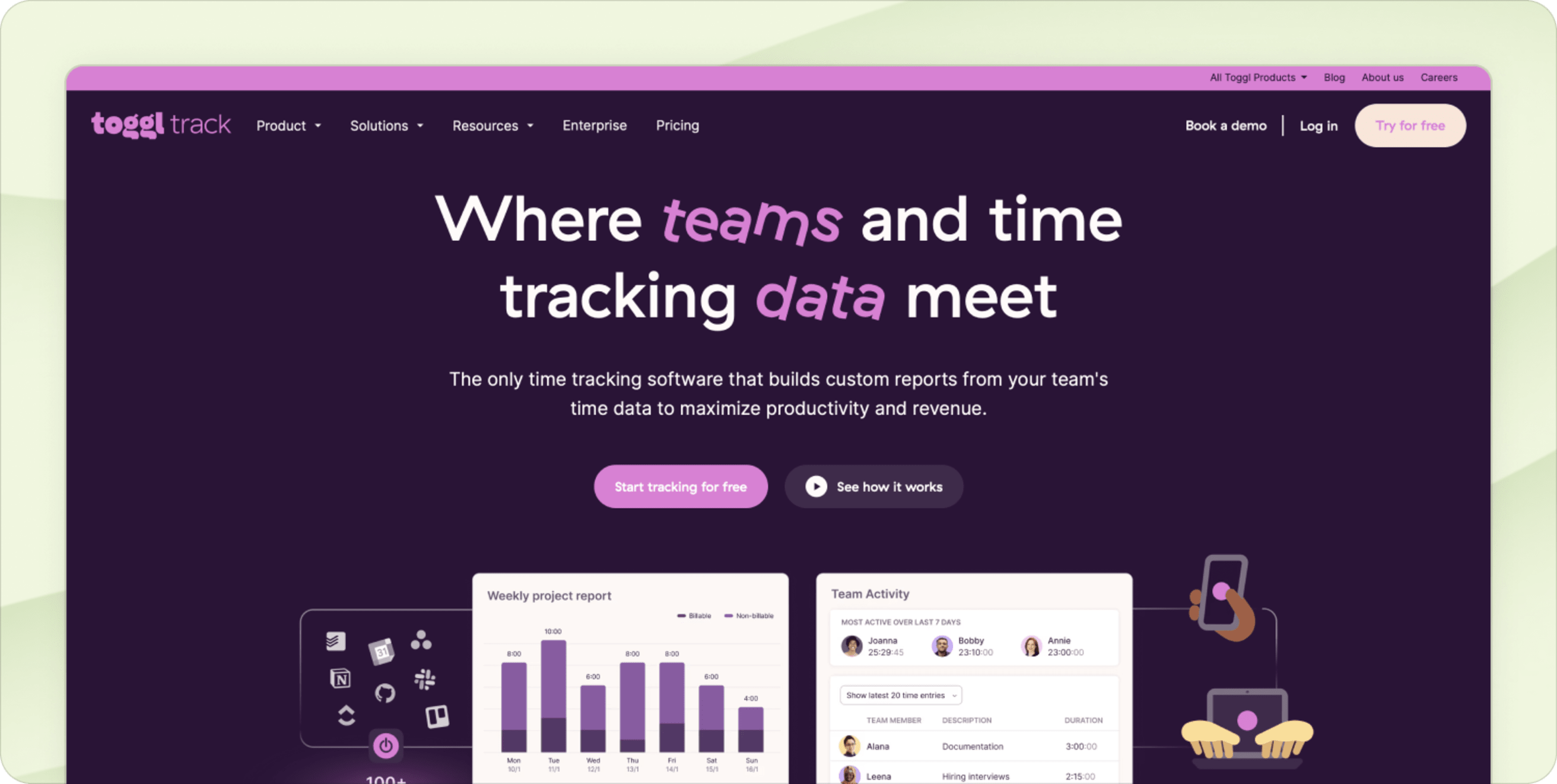
Toggl is both a time tracking and a project management tool. You can track your time with a single click using a time entry. Once you start, you choose a project, write a description of the task, and add any relevant tags.
Also, you can track your time while on the move with Toggl’s mobile app.
What's cool about it:
Group time entries by client, project, or task type
Sync with your calendar and view your time entries
Use the Pomodoro timer to focus in intervals
Create sub-tasks and assign them to different team members
Analyze time data by client, team, project, tasks, etc
Best for: Freelancers, consultants, and teams who need to track billable hours. It’s ideal for anyone who wants to understand how long specific tasks take and needs time tracking for billing.
Price tag:
Free: Full features for up to 5 team members
For small teams: $9/user per month for advanced team features
Growing teams: $18/user per month for enterprise solutions
Health and fitness tracking applications
With modern fitness trackers and health apps, your health isn't only about how you're feeling right now. It's about how you feel over time as you make new changes to your lifestyle.
Does your new bedtime routine improve your sleep quality? Has your resting heart rate changed since you started running?
The right tracking tools, especially wearable fitness devices, turn vague health goals like "get fit" or "sleep better" into measurable improvements you can see.
4. Apple Health
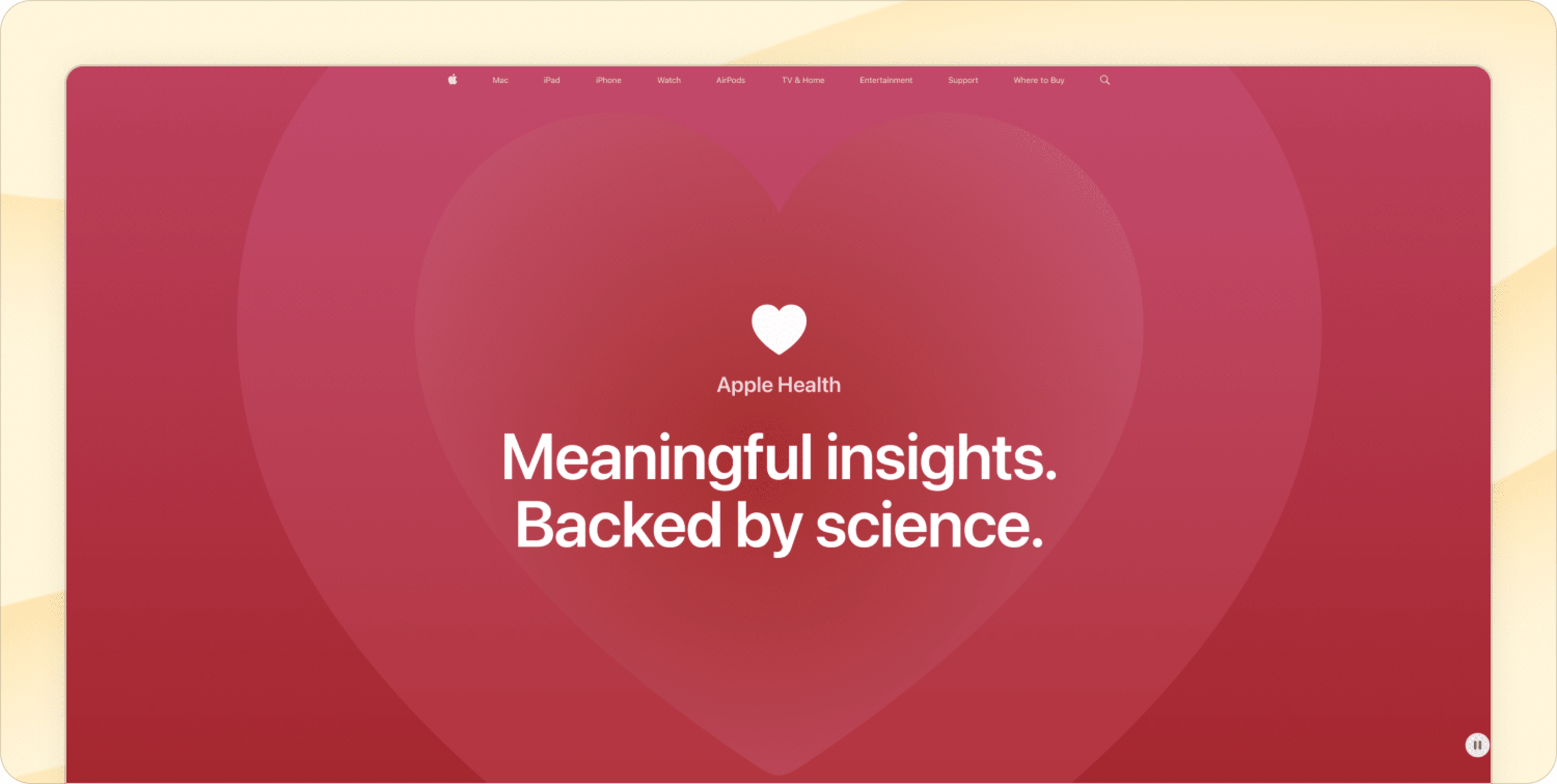
Health is a native app from Apple that enables quantified tracking of your well-being. It can track activity patterns and vital trends continuously through wearable devices like the Apple Watch.
The app does more than just track data — it measures and analyzes vital health metrics. You'll get reminders when it's time to take your prescriptions, insights about your sleeping patterns (including potential breathing disturbances that might indicate sleep apnea), and even hearing health assessments when paired with AirPods Pro 2.
What's cool about it:
View the things that matter to you (steps from trackers, sleep, or vitals) in the activity board
Analyze your sleep stages from last night (REM, Core, and Deep)
Share your health data with your loved ones
Create a medical ID and store health information for emergencies
Track your vitals, everything from heart rate to blood oxygen levels
Best for: iPhone or Apple Watch users who want to understand their health patterns. Apple Health is perfect for both casual users and fitness enthusiasts who need from basic to detailed health metrics.
Price tag: It comes pre-installed for free on all iPhones or Apple Watch
5. MyFitnessPal

MyFitnessPal is often recognized as the best app to track nutrition, helping you understand exactly what's on your plate at a macros level. It has one of the largest food databases in the world, making it easy to get nutritional data on anything you eat.
With MyFitnessApp, you can log your exercise and categorize it as cardio, strength, or other workout routines. The app takes this into account when calculating your goals. It also promotes healthy habits by giving you a weekly report of your fruits and veggies.
What's cool about it:
Log packaged foods in your macros using the barcode scanner
Track your calories, nutrients, and macros daily or weekly
Set personal custom goals for calories and macros
Use the diary function to log physical activity and water intake
Find nutrition facts from thousands of restaurants in your area
Best for: Anyone who wants to exercise more and understand their eating habits. MyFitnessPal is perfect for both beginners learning about nutrition and experienced trackers monitoring detailed macros.
Price tag:
Free: Basic food tracking and calorie counting
Premium: $79.99/year for advanced nutrition insights and meal planning
6. Sleep Cycle
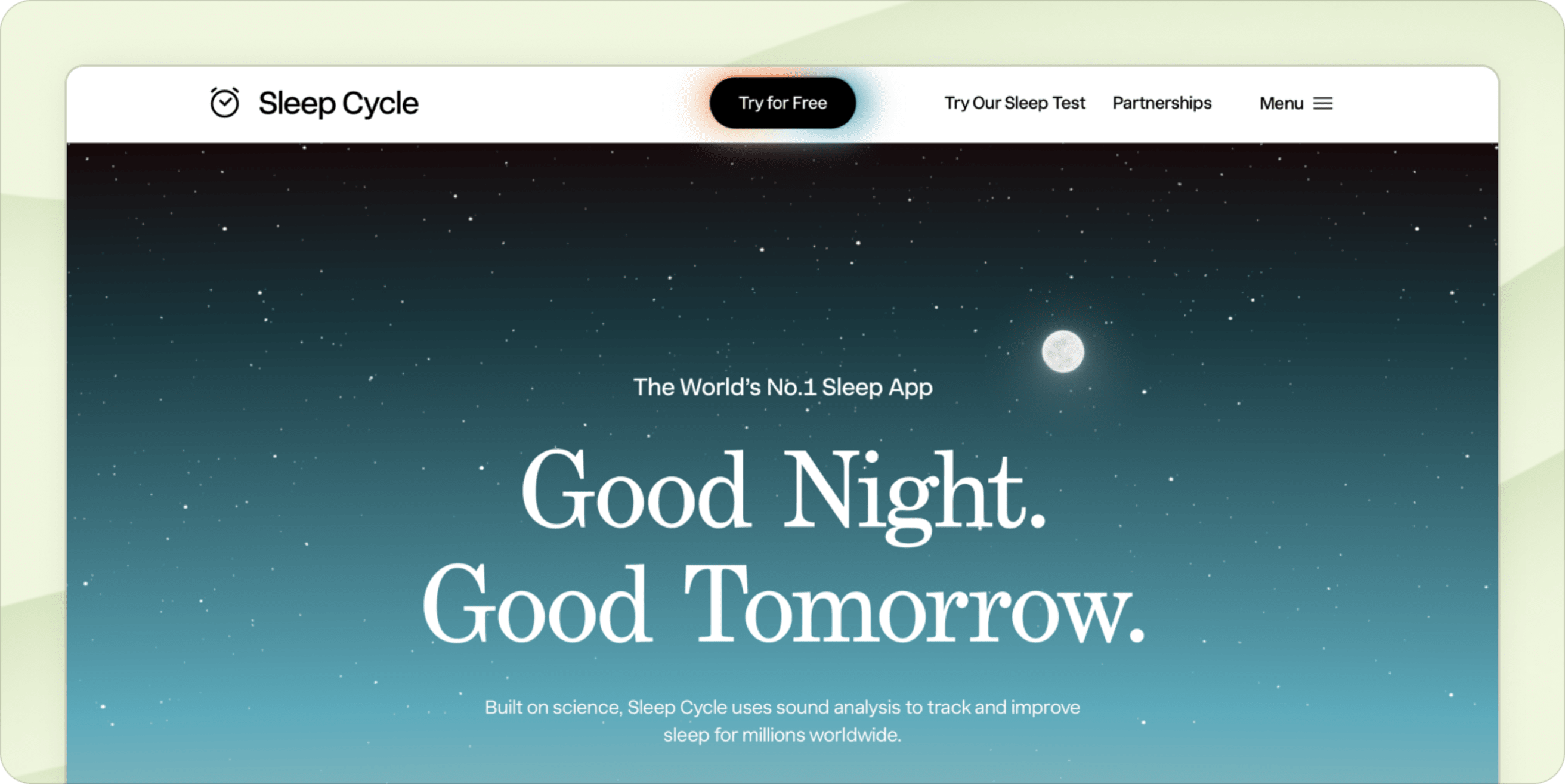
Sleep Cycle is a tool that measures and analyzes your sleep by actively getting feedback from you. You can set an alarm with or without a wake-up window. When you wake up, the app asks for your "wake-up mood" to see if there's a correlation between your sleep patterns (snoring, coughing, or sleep talking) and quality of sleep.
What's cool about it:
Wake up within a 30-minute window in your highest sleep phase with the smart alarm
Use your sleep journal and statistics to track how your daily habits affect your sleep
Record snoring to understand nighttime breathing patterns
Better the quality of your sleep with music and guided meditations
Best for: Groggy people with irregular schedules who want to wake up feeling more refreshed and energized.
Price tag:
Free 7-day trial: Basic sleep tracking and smart alarm
Premium: $39.99/year for detailed sleep analysis and trends
Book and reading progress tracking apps
If you're like most readers today, your reading life likely spans multiple formats — ebooks, online articles, physical books, and more. Without a way to track them all, it's easy to lose sight of what you're reading and when you last picked up each book. A good tracking app helps you bring all your reading into one organized system.
However, tracking your reading isn't just about counting books or pages. It's also about answering the following questions:
What genres or topics draw you in?
Which formats help you retain information better?
Are you getting enough time for the books you want to read?
When you can see your reading patterns clearly, you make better choices about what to read next. Plus, tracking your progress across different platforms helps you pick up right where you left off.
7. Goodreads
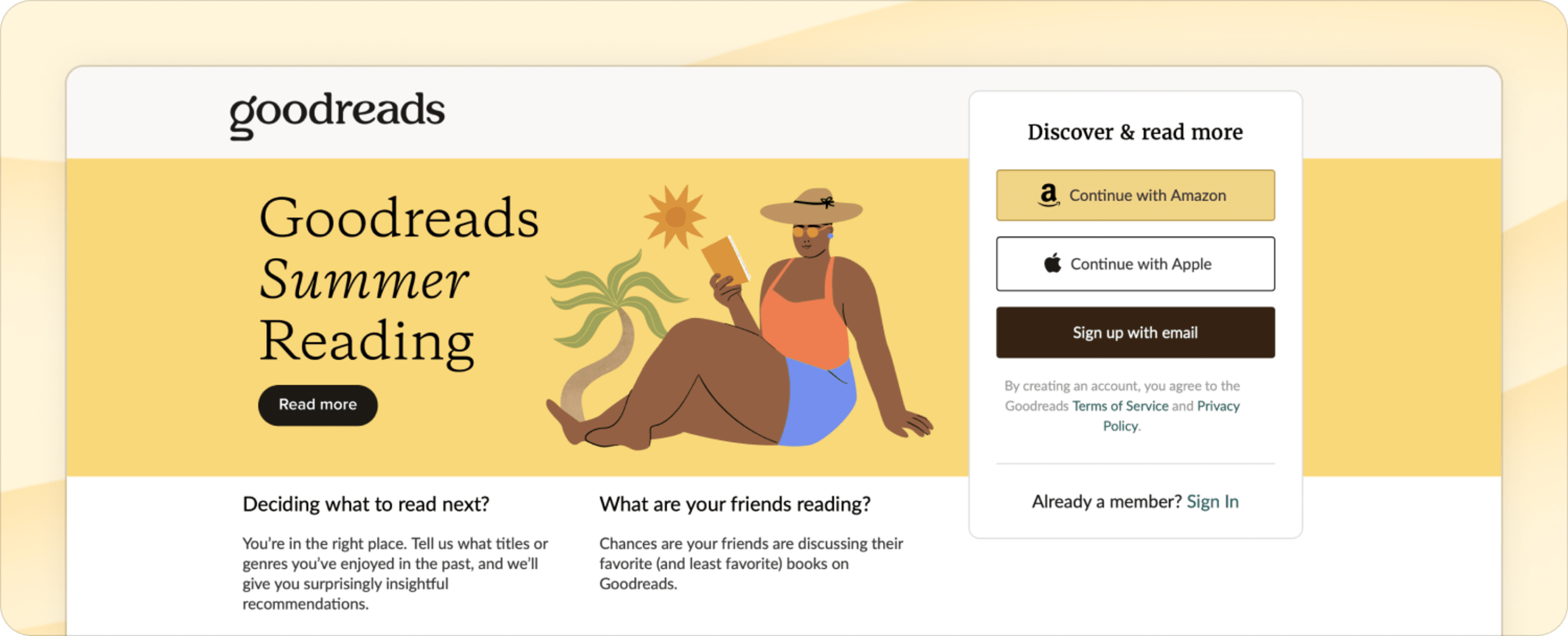
Goodreads is one of the best apps for tracking reading where you can see and review all the books you've read. One of its major highlights is the book recommendation engine. It analyzes 20 billion data points to give you suggestions for your next read.
What's cool about it:
Set yearly reading goals and view the analytics of your reading habits
Scan book covers with your phone and add them to your in-app shelves
Organize your books by genre, mood, or create your own categories
Follow your favorite authors and see your friend's reviews on books
Get personalized book recommendations tailored to your tastes
Best for: Book enthusiasts tracking their yearly reading goals and progress. It's especially helpful for readers who don't know what to read next. They can connect with a community that shares their reading interests.
Price tag: Free, all features are available at no cost
8. Instapaper
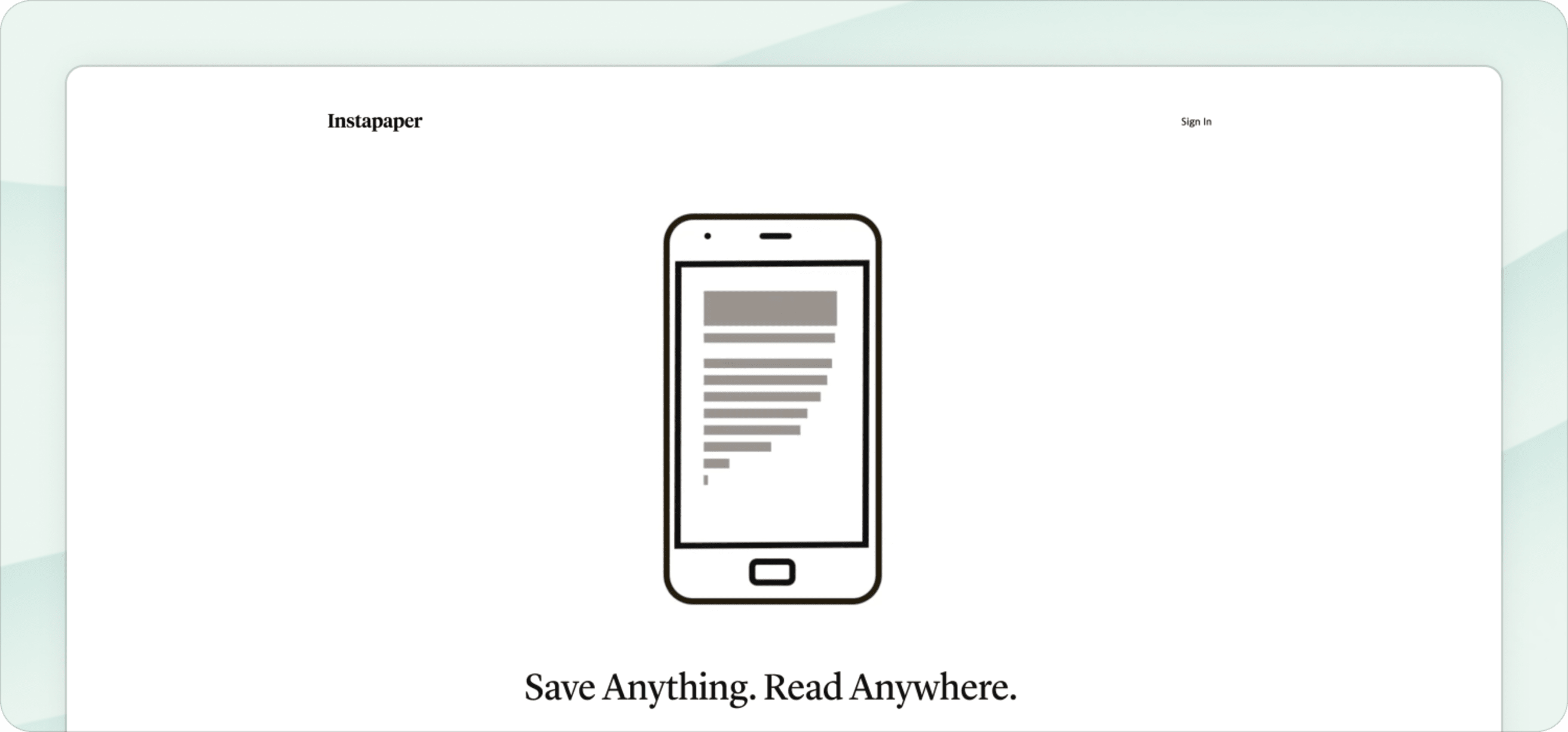
Instapaper is a reading management app that transforms online articles into a simple, distraction-free reading format. The app goes beyond basic organization by tracking your reading speed, preferences, and completion rates, helping you understand what and how you read.
What's cool about it:
Measure your average reading pace and time spent per article
Sort articles into custom collections with the folder system
Adjust screen brightness (dark mode or light mode)
Sync your progress across all devices
Use full-text search for all articles in your account
Best for: Digital readers who want to save articles for longer reads later without distractions. Instapaper works for professionals who want to organize research materials or article collections.
Price tag:
Free: Basic article organization and saving capabilities
Premium: $5.99/month ($59.99/year) with advanced text-to-speech and speed reading
Personal finance and expense tracking apps
Setting your financial goals is easy, but measuring and following through is where most of us struggle. Whether you want to save more, spend less, or invest regularly, sometimes, small purchases here and there get in the way.
A financial tracking app can help you bridge the gap between your money intentions and your actual behavior. It gives you an unfiltered view of your financial reality.
For example, when you notice your takeout spend racks up to $300 per month (or $3,600 a year), you can make more conscious choices about your spending.
9. Rocket Money
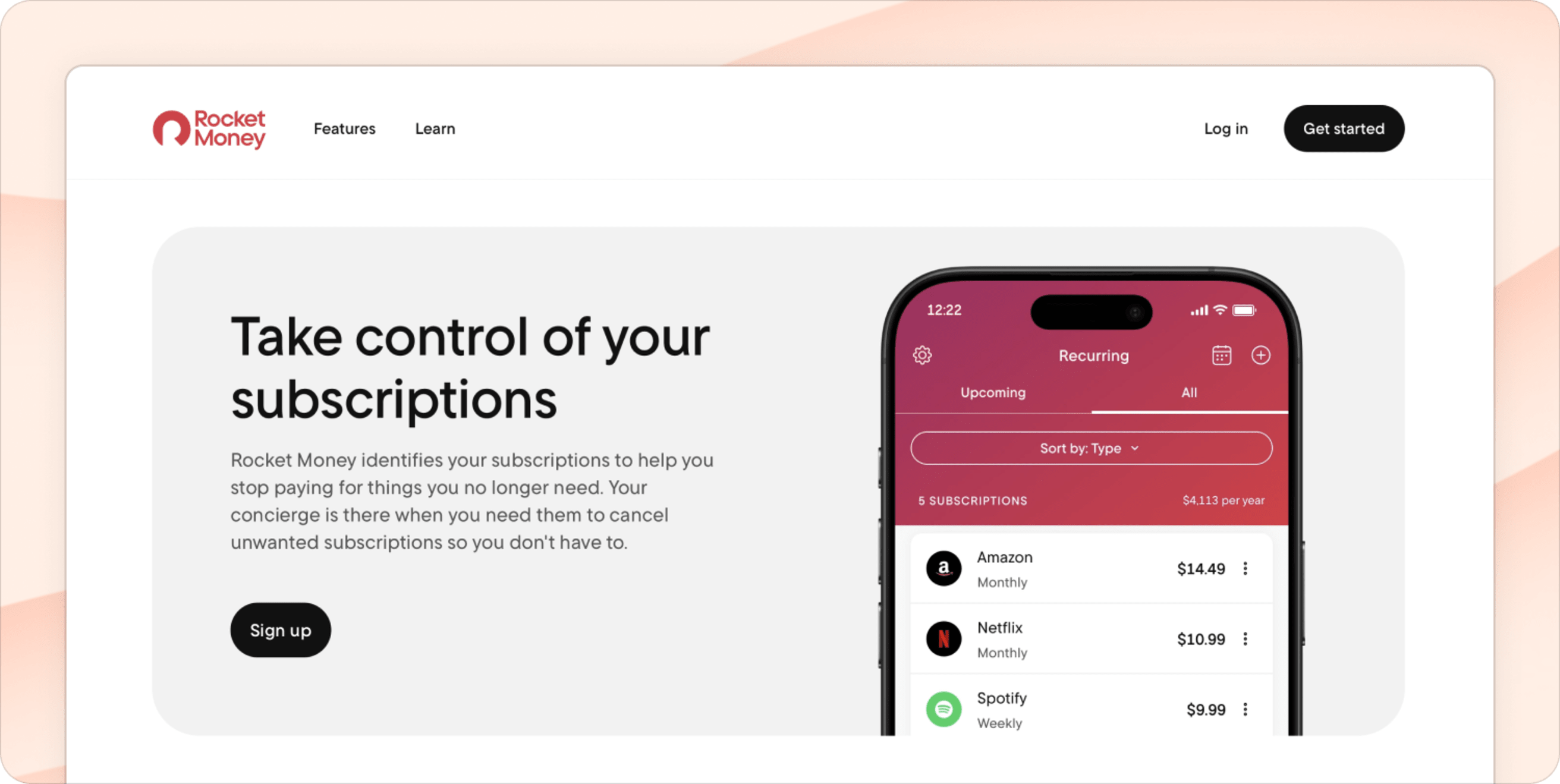
Rocket Money is a financial tracking app that scans wasteful spending habits. It identifies recurring payments and provides a list of your subscriptions so you can check which ones you don't use anymore.
Rocket Money analyzes your spending and shows you when bills are due, helping you plan to avoid overdrafts or late fees.
It stands out for its concierge feature which handles canceling unwanted subscriptions. Plus, they negotiate your bills (car insurance, cell phone, or overdraft fees) to get the best rates possible.
What's cool about it:
Set aside money based on your spending patterns automatically
Create spending goals for each custom category
Get alerts whenever you're close to your desired spending
Analyze your spending insights to adjust your habits and reach your goals
Monitor your net worth over time by linking all your accounts
Best for: Anyone who wants a simpler way to manage their money. Rocket Money is ideal for anyone tired of dealing with forgotten subscriptions and complex bill negotiations.
Price tag: Free 7-day trial and then $6-$12/month
10. YNAB (You Need a Budget)

YNAB is a financial planning tool that uses zero-based budgeting as a principle. You organize your finances by assigning a job to every dollar you earn, aligning with your goals. Before you spend, you check your plan and move money around to ensure you still meet your targets.
The app has a clean interface like a spreadsheet where you can see your categories and items line by line. Also, it has a progress bar to check how close you are to reaching your goals.
What’s cool about it:
Group different bills under categories and assign every dollar a specific job
Check your budget for an activity, how much you actually spent, and what's left available
Set goals and calculate how much you need to save weekly, monthly, or yearly.
Analyze your spending by categories or accounts with detailed reports
Explore the loan planner to tackle your debt
Best for: People who prefer seeing a line-by-line breakdown of their spending. YNAB works for individuals who want to be more intentional about their spending habits and are working towards specific goals.
Price tag:
Free trial: 34 days to test all features
Paid plan: $14.99/month (or $9.08/month billed annually)
11. Quicken Simplifi
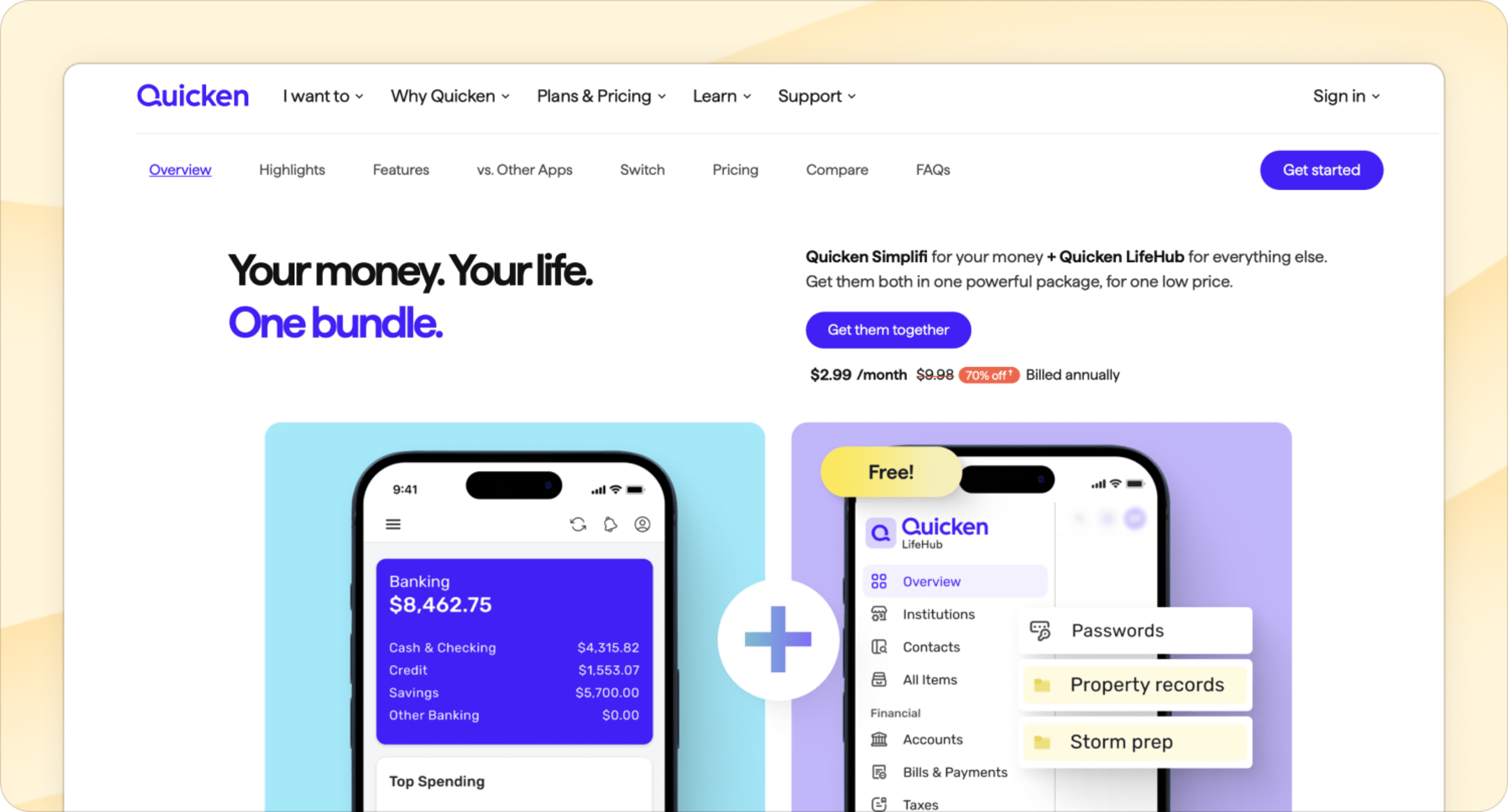
Quicken Simplifi is a finance tool that stands out for its visual interface. In the overview tab, you can visualize the most important info using filters. The app connects to your accounts and automatically organizes your spending, savings, and investments.
You can manage your net worth by entering the value of your home using a Zillow integration. Plus, you can keep track of your investment portfolio with performance analysis tools.
What's cool about it:
Adapt to your spending plan (zero-based budgeting, envelope budgeting, 50-30-20, etc.)
Track your savings and how much you can spend while meeting your goals
Monitor specific categories where you want to reduce spending with watchlists
Project future cash flow based on regular earnings and bills
Share your account or add your partner to reach common goals
Best for: Busy professionals who want a low-maintenance but robust money management tool. Quicken works for those who prefer flexible planning rather than strict budgets.
Price tag: $5.99/month (or $2.99/month billed annually)
Media consumption and entertainment tracking tools
Think about all the content you consume daily. TV shows, podcasts, music, and the occasional doom-scrolling can take a significant chunk of your time.
Now, imagine it quantified.
By understanding your media consumption habits, you can make better choices about your free time. Instead of mindlessly switching between entertainment platforms, you can be more intentional with what you watch.
12. Trakt.tv
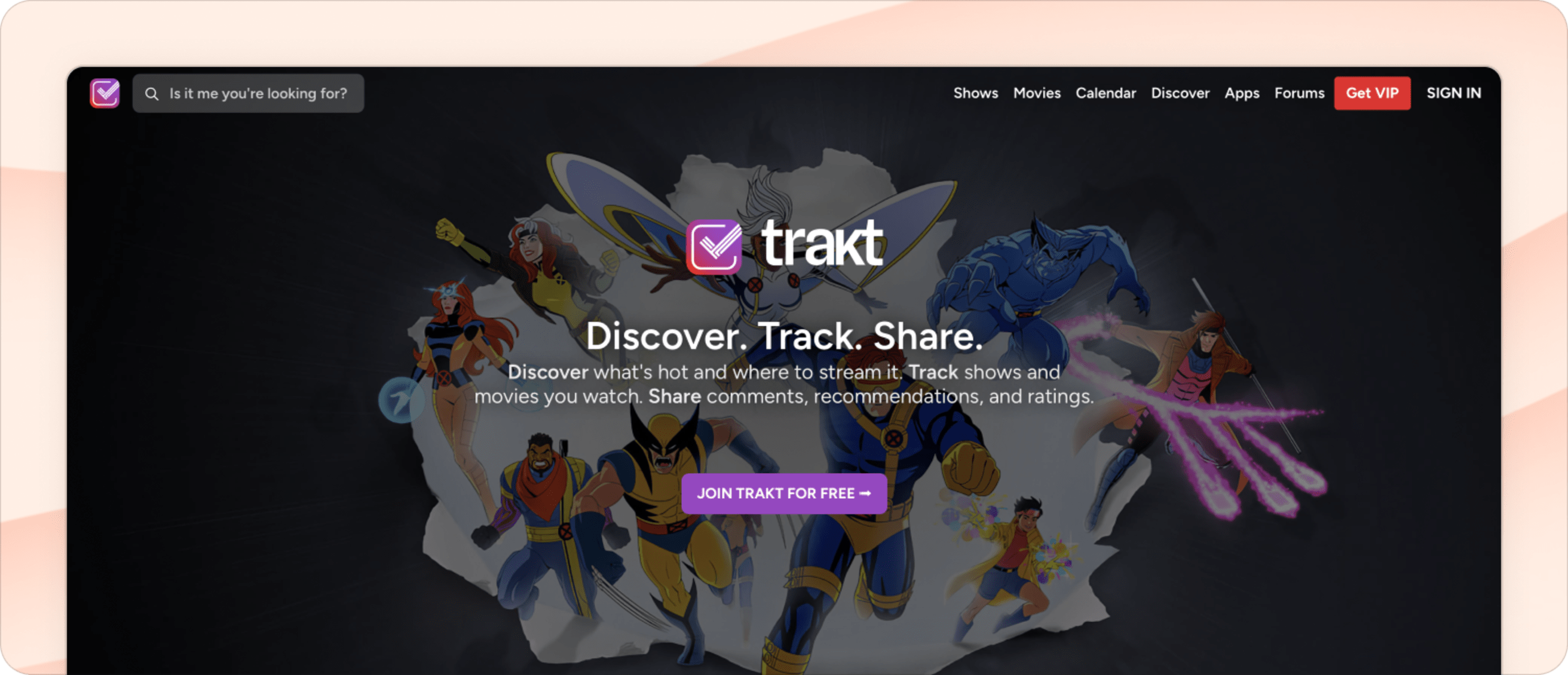
Trakt.tv is an app that tracks your movie and TV-watching habits across your streaming platforms. Its visual capabilities allow you to see binge-watching stats per year, month, week, and day. You can see a personalized breakdown of your watching habits and preferences.
Trakt.tv stands out because of its collaboration feature. You can follow your friends and create lists with notes on your favorite shows.
What's cool about it:
See upcoming episodes for shows you follow in the calendar view
Get personalized recommendations for new shows and movies
Visualize your stats or get a year in review (hours, most watched shows, genres, etc.)
Add private or public notes for reference when watching a show
Follow your friends and create collaboration lists
Best for: Anyone who regularly loses track of which episode they're on. Trakt.tv is ideal for TV and movie enthusiasts that have multiple streaming services and want to track their viewing habits.
Price tag:
Free: Basic tracking and watchlist features
VIP: $6/month or $60/year for advanced stats and no ads
13. Last.fm

Last.fm tracks every song you play across your music streaming services. The app analyses your listening patterns to give you a profile adapted to your music taste. It turns this data into personalized music recommendations and connects you with concerts from artists you frequently play.
What's cool about it:
Check historical reports of your top artists and genres for different periods
Get notifications or events when your favorite artists are playing
Integrate with Spotify, Apple Music, and most music services
Be part of a community and start discussions on your favorite artist's page
Best for: People who love learning about their listening habits and are curious about how their music taste evolves.
Price tag:
Free: All core features available
Pro: $4.99/month (or $49.99/year) for ad-free experience
14. Listen Notes
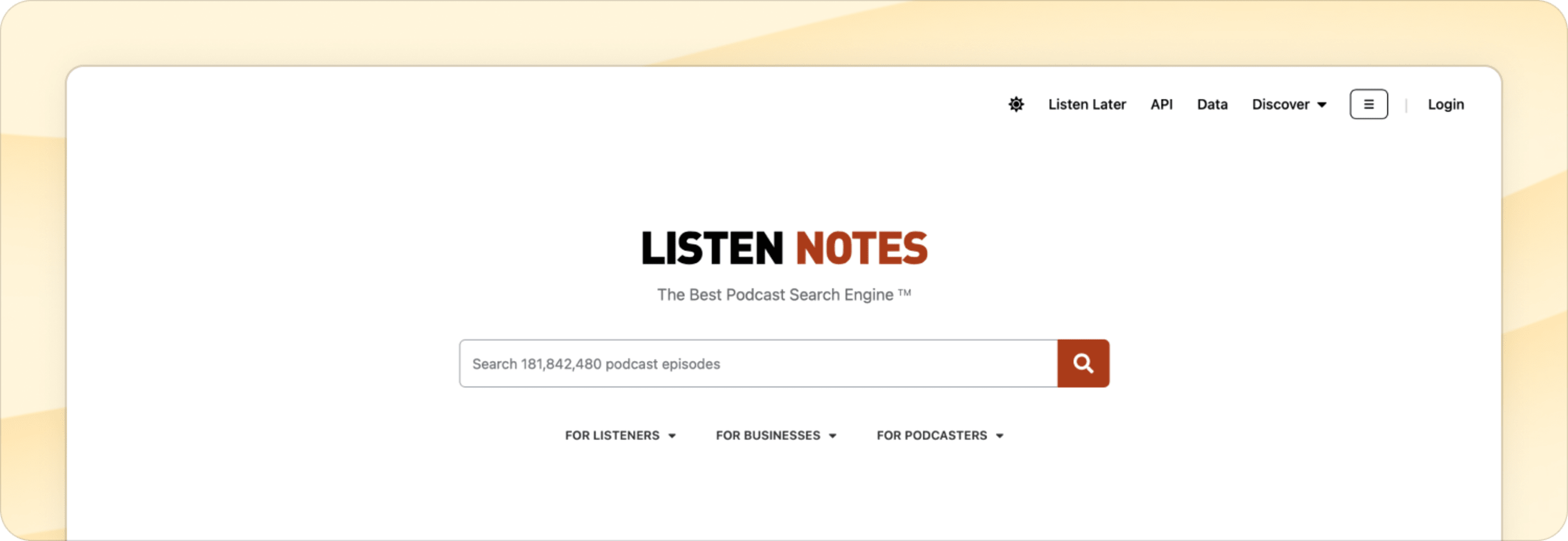
Listen Notes is the best podcast search engine — like Google but for podcasts. The app catalogs millions of episodes across different podcast platforms to create a personalized database for you. It helps you both discover and monitor your listening habits.
What's cool about it:
Organize podcast episodes into custom listening queues
Record your listening time and completion rates
Find specific topics across all podcast episodes
Discover niche podcasts
Sync your data across different podcast apps and devices
Best for: Regular podcast listeners managing multiple shows and episodes. However, professionals and content creators will find it useful to track industry trends and analyze listening patterns.
Price tag:
Free: Basic search and tracking features
Premium: $180/month for advanced features and API access
How to build a simple quantified self system
Before you go on a download spree, let's build a self-tracking system that won't have you drowning in data. The key to successful quantification is starting simply.
You don’t need to track everything, just what matters in a way that helps you with your self-improvement journey.
With Todoist as your main hub, you can keep those daily numbers ticking in the background while focusing on what really counts: taking action. You don’t need to constantly check your progress. Just concentrate on showing up and doing the work.
1. Set up your Todoist foundation
Choose the areas of your life you want to concentrate on. You can create separate projects for each area or focus on tracking just the one that matters the most to you right now. For productivity, you might want to track anything from daily errands to personal projects or work.
Within each project, create sections for:
Daily tasks
Quarterly or yearly goals
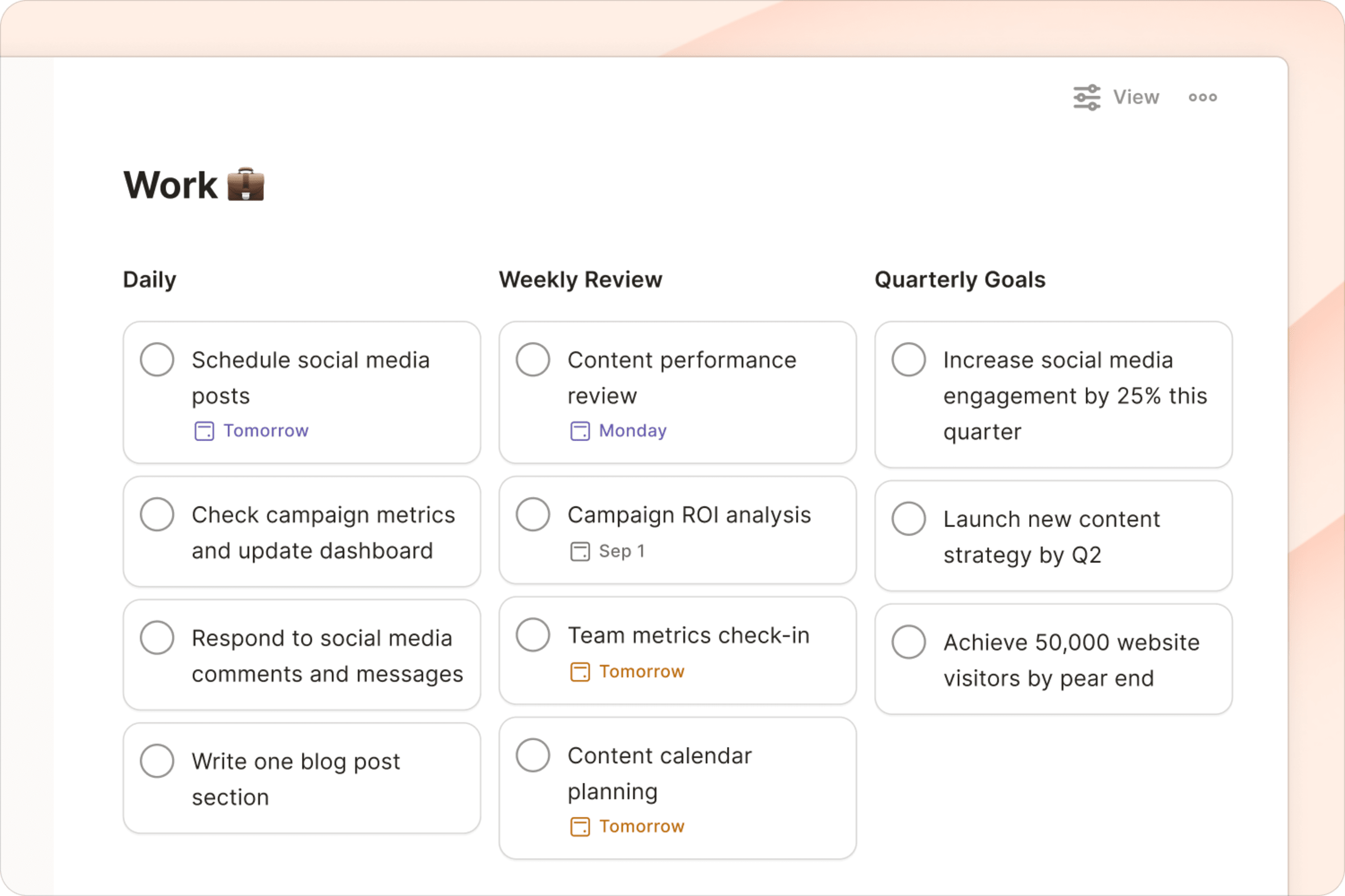
After deciding which life areas you'll track, it's time to populate each section with tasks. In your daily tasks, include the specific actions that will move you toward your goals. Schedule reminders and add any goal-related tasks that will keep you accountable.
For your reviews section, set up weekly and monthly check-ins as recurring tasks. These regular check-ins aren't just about tracking progress — they help you stay motivated by showing how far you've come.
Set up SMART goals in the quarterly or yearly goals section to serve as your north star. As you complete daily tasks and review your progress, you'll see exactly how your consistent actions add up to meaningful achievements over time.
2. Connect your essential apps
Start with just one integration and gradually add others as you become comfortable with your system. Focus on the connections that directly support your most important goals.
Here are some essential apps you can connect with Todoist:
Apple Watch: While Todoist doesn't integrate directly with Apple Health, you can use the Todoist widget on Apple devices. Check off your health-related tasks right from your wrist using the Todoist app. Meanwhile, Apple Health quietly collects your detailed health data in the background.
YNAB: Connect Todoist to YNAB to keep track of changes in your spending plan. You can create triggers that automatically add tasks in Todoist of things that need your attention. For example, when a category goes over budget or an account balance runs low.
When it comes to entertainment tracking, you'll want to use a dedicated app from our list above. However, you can still maintain awareness of your entertainment consumption by scheduling regular review tasks in Todoist.
Note
Remember: Review and adjust your integrations periodically. If you find yourself ignoring certain automated tasks or feeling overwhelmed by notifications, simplify your setup. The most effective tracking system is one you'll actually use consistently.
3. Make it all work together
Your data tracking system needs a regular review schedule to be useful. When you check your data at different intervals (daily, weekly, and quarterly) you can spot patterns and make adjustments.
Remember that the goal isn't just to collect data. It's to regularly review and act on what you learn. Here's how all the pieces fit together, from daily tasks to long-term tracking:
Timeline | Action |
|---|---|
Daily: focus on Todoist | • Open your projects or just check your “Today” tasks • Complete your tasks • Trust that your specialized apps are recording the data |
Weekly or monthly: quick check-in | • Spend 5 minutes reviewing your specialized apps • See how your daily actions add up • Adjust next week's tasks if needed |
Quarterly or yearly review: the big picture | • Look at your trends in each app • Celebrate your progress • Update your goals if needed |
If you're the kind of person who likes to check their progress and see what you've achieved each day, you can enable daily digests in Todoist. You'll get a satisfying email snapshot of all the tasks you completed that day.
You can also go to the "completed" section in Todoist's left-hand menu bar and filter your tasks by project.
Note
Pro tip: Set daily and weekly goals in Todoist for the number of tasks you want to complete. For example, you might aim to complete 5 tasks each day or 25 tasks each week. When you hit your goal, you'll get a celebration animation on your screen.
Self-knowledge through numbers
The journey of quantitative self isn't about becoming obsessed with every metric. Your goal isn't to mindlessly track everything — it's to build better habits through consistent daily actions. Todoist reminds you what to do, and your specialized apps quietly track how you're doing.
Keep it simple, focus on actions you can take today, and let the data collection happen naturally in the background. That's the secret to sustainable self-tracking.
